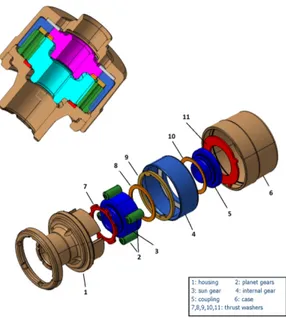Analysis of Stresses in Vehicle Driveline Systems Using a
Flexible Multibody Approach
Geoffrey Virlez∗, Olivier Br ¨uls∗, Nicolas Poulet†, Emmanuel Tromme∗, Pierre Duysinx∗
∗
Department of Aerospace and Mechanical Engineering (LTAS), University of Li`ege Chemin des chevreuils, 1, B52/3, 4000 Li`ege, Belgium
{geoffrey.virlez|o.bruls|emmanuel.tromme|p.duysinx}@ulg.ac.be
†JTEKT TORSEN S.A.
Rue du grand peuplier, 11, Parc industriel de St´epy, 7110 Str´epy-Bracquegnies, Belgium npoulet@torsen.be
ABSTRACT
Drivetrain components highly impact the dynamic performance of vehicles. For instance, a dif-ferential manages the vehicle steering ability and therefore increases the safety. The transmis-sion devices are submitted to sizable magnitudes of force and torque as well as large vibrations which involve high stresses in components such as driveshafts. That often needs massive me-chanical parts which penalize the energy efficiency.
The system modeled in detail in this work is the TORSEN differential. This transmission com-ponent contains an epicyclic gear train, several thrust washers and a housing in two parts. The locking effect and torque transfer of this kind of limited slip differential is only due to fric-tion inside the differential. This critical mechanical device is subjected to numerous complex phenomena such as backlash between gear teeth, impact, stick-slip, hysteresis,... An accurate modelling of these discontinuous and non linear effects is not trivial and can lead to numerical problems during simulations.
Various dynamic models of type B and C TORSEN differentials have been developed in pre-vious works (see [2]) and have been globally validated by comparison with experimental data. Each gear pair is modelled by a flexible nonlinear joint defined between two nodes (one at the rotation center of each wheel) and is able to account for specific characteristics: mesh stiffness fluctuation, backlash, load transmission error and misalignment. The vehicle and driveshafts are not represented in theses models which are mainly composed of rigid bodies. Equivalent load cases are applied on the differential inputs and outputs. The nonlinear finite element approach for flexible multibody systems has been used (see [1]). This method is available in the software SAMCEF/MECANO and allows the modelling of complex mechanical systems composed of kinematics joints, force elements and rigid bodies or structural components (beam, shell, vol-ume, superelement,...). The numerical solution is based on a Newmark-type integration scheme with numerical dissipation, which is combined with a regularization of discontinuities and non-smooth phenomena in the system.
In this work, the objective is to study the interactions between the differential and the vehicle dynamics. The detailed TORSEN differential models (Fig. 1) are introduced in a full vehicle model including: a flexible chassis composed of beam elements, a steering system, suspensions fixed to the chassis with bushings, Pacejka tyre models. The differentials are connected to the driving wheels with rigid or flexible driveshafts and constant velocity joints.
8th European Solid Mechanics Conference Gerhard A. Holzapfel and Ray W. Ogden (Eds) Graz, Austria; July, 2012
Figure 1:Exploded diagram and cut-away of type C TORSEN differential.
The numerical simulation enables to study the impact of torque transfers produced by TORSEN differentials on the dynamic behaviour of the vehicle. The influence of the modification of dif-ferential parameters can be studied in various situations such as vehicle manoeuvres or driving wheels with different conditions of adherence. For instance, the effect on road handling can be observed if the friction coefficient of the thrust washers is modified.
Backlash, impact, mesh stiffness fluctuation,... are some examples of transient phenomena which can generate vibrations and high stresses in driveshafts and differential housing. The differential output shafts are modeled with flexible elements (finite element or superelement) to analyse the stress distribution or the propagation of vibrations. The results provided by this analysis can be used to improve the driveshaft design.
Acknowledgement. The author, Geoffrey Virlez, would like to acknowledge the Belgian National Fund for Scientific research (FRIA) for its financial support.
References
[1] M. G´eradin and A. Cardona, Flexible Multibody Dynamics. A Finite Element Approach. John Wiley & Sons, 2001.
[2] G. Virlez, O. Bruls, N. Poulet and P. Duysinx, Simulation of differentials in four-wheel drive vehicles using multibody dynamics, in: Proc. of the ASME 2011 IDETC/CIE 2011, Washington D.C., USA, 2011.
8th European Solid Mechanics Conference Gerhard A. Holzapfel and Ray W. Ogden (Eds) Graz, Austria; July, 2012
